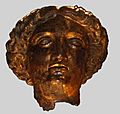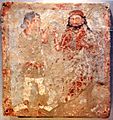Interpretatio graeca facts for kids
Interpretatio graeca (say "in-ter-pray-TAH-tee-oh GRAY-kah") is a Latin phrase that means "understanding through Greek ideas." It describes a way people in Ancient Greece tried to make sense of the mythology and religion of other cultures. They did this by comparing other cultures' gods and myths to their own Greek ones.
The term interpretatio romana (say "in-ter-pray-TAH-tee-oh roh-MAH-nah") is similar. It was first used by a Roman historian named Tacitus in his book Germania. This term refers to how the Romans used their own gods and myths to understand the gods and beliefs of other cultures they met.
Basically, both ideas were about finding similarities between different religions. For example, if another culture had a god of the sky, the Greeks might say, "That's like our Zeus!" The Romans might say, "That's like our Jupiter!" This helped them understand and connect with people from different lands. Sometimes, they even gave their gods new names or titles based on these comparisons.
Contents
Understanding Different Gods
Imagine you meet someone from a different country. They tell you about their favorite sport. You might try to understand it by comparing it to a sport you already know. This is a bit like what interpretatio graeca and interpretatio romana were about.
Ancient Greeks and Romans often met people with very different beliefs. Instead of saying "your gods are wrong," they tried to find common ground. They looked for gods in other cultures that had similar jobs or powers to their own gods.
How it Worked
When the Greeks or Romans encountered a new god, they would ask:
- What is this god in charge of? (Like the sky, war, love, or wisdom?)
- What stories are told about this god?
- What are their special symbols or animals?
If a god from another culture was the god of war, the Greeks might call them "Ares" (their god of war). The Romans would call them "Mars" (their god of war). This made it easier for them to understand and even worship these foreign gods alongside their own.
Examples of Connections
One famous example is the Egyptian goddess Isis. When the Romans learned about Isis, they saw her as a powerful goddess who protected people. They started to worship her in Rome, connecting her powers to some of their own goddesses.
Another example is the god Serapis. This god was created in Ancient Egypt during the time of the Greeks. He was a mix of Greek gods like Zeus and Hades and Egyptian gods like Osiris and Apis. This helped both Greeks and Egyptians feel connected to the same god.
This process of mixing and matching gods helped different cultures get along. It also allowed new religious ideas to spread and become popular across the ancient world. It showed that people in ancient times were often open to new ideas about religion.
Images for kids
-
Gilt bronze head from the cult statue of Sulis Minerva from the Temple at Bath
-
Isis, Serapis, the child Harpocrates and Dionysos (relief from Roman Africa, late 2nd century AD)
-
Worshipper before Zeus–Serapis–Ohrmazd (Bactria, 3rd century AD)
See also
 In Spanish: Interpretatio graeca para niños
In Spanish: Interpretatio graeca para niños







